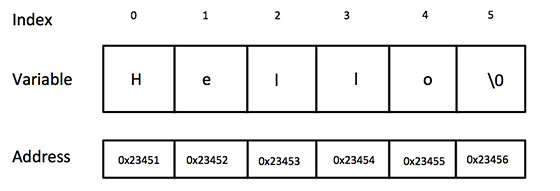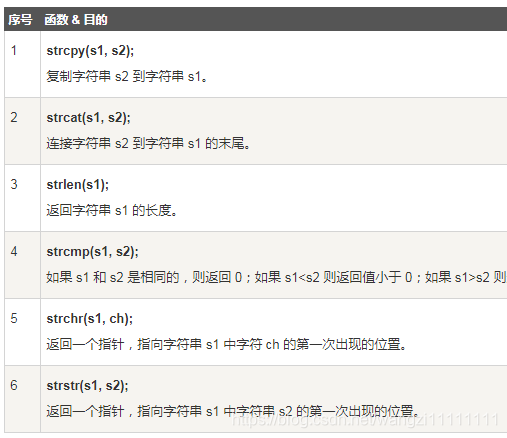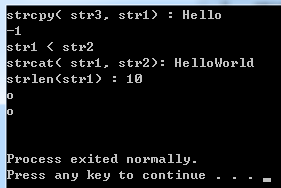文章目录
- 目录
- 一.c风格的字符串与操作函数
- 1.c风格字符串
- 2.c风格字符串处理函数
- 二.c++中的字符串与操作函数
- 1.c++中的string类
- 2.string类的基本操作
- 3.string类的操作汇总
目录
- 数据结构:
- 逻辑结构:数组,栈,队列,字符串,树,图
- 存储结构:顺序存储,链式存储
- C++常用的数据结构有:string , stack , queue , deque , vector , list , map , iterators.

参考博客
注意
可以将字符串看成一种特殊的顺序表,特殊之处在于表的节点只能存储字符串。由于字符串相邻元素的位置是由关系的,即顺序关系,不建议用链式存储结构存储
一.c风格的字符串与操作函数
1.c风格字符串
C风格的字符串起源于 C 语言,并在 C++ 中继续得到支持。
字符串实际上是使用 null 字符 ‘\0’ 终止的一维字符数组。
因此,一个以 null 结尾的字符串,包含了组成字符串的字符。
下面的声明和初始化创建了一个 “Hello” 字符串。
由于在数组的末尾存储了空字符,所以字符数组的大小比单词 “Hello” 的字符数多一个。
char greeting[6] = {'H', 'e', 'l', 'l', 'o', '\0'};//依据数组初始化规则,您可以把上面的语句写成以下语句:char greeting[] = "Hello";
以下是 C/C++ 中定义的字符串的内存表示:

其实,您不需要把 null 字符放在字符串常量的末尾。
C++ 编译器会在初始化数组时,自动把 ‘\0’ 放在字符串的末尾。
让我们尝试输出上面的字符串:
#include <iostream>
using namespace std;
int main (){char s1[6] = {'H', 'e', 'l', 'l', 'o', '\0'};char s2[6] = {'H', 'e', 'l', 'l', 'o'};char s3[] = "hello"; //编译器会根据字符串长度的大小初始化字符数组的cout << s1 << endl;cout << s2 << endl;cout << s3 << endl;
}
Hello
Hello
hello
2.c风格字符串处理函数
C++ 中有大量的函数用来操作以 null 结尾的字符串

下面的实例使用了上述的一些函数:
#include <iostream>
#include <cstring>using namespace std;int main ()
{char str1[11] = "Hello";char str2[11] = "World";char str3[11];int len ;// 复制 str1 到 str3strcpy( str3, str1);cout << "strcpy( str3, str1) : " << str3 << endl;// 比较 str1 和 str2的大小cout<< strcmp(str1, str2) <<endl; if(strcmp(str1, str2)>0)cout<<"str1 > str2"<<endl;else if(strcmp(str1, str2)<0)cout<<"str1 < str2"<<endl;elsecout<<"str1 = str2"<<endl;// 连接 str2 到 str1strcat( str1, str2);cout << "strcat( str1, str2): " << str1 << endl;// 连接后,str1 的总长度len = strlen(str1); //strlen计算字符串长度的时候,没有计算尾部 '\0'元素cout << "strlen(str1) : " << len << endl;// 返回一个指针,指向字符串 str1 中字符 ch 的第一次出现的位置char *p;char ch = 'e';p = strchr(str1, ch);cout<<*(p+3)<<endl;// 返回一个指针,指向字符串 s1 中字符串 s2 的第一次出现的位置char *p2;char s2[] = "ll";p2 = strstr(str1, s2);cout<<*(p2+2)<<endl;
}

二.c++中的字符串与操作函数
1.c++中的string类
C++ 标准库提供了 string 类类型,支持上述所有的操作,另外还增加了其他更多的功能。我们将学习 C++ 标准库中的这个类,现在让我们先来看看下面这个实例:
#include <iostream>
#include <string>using namespace std;int main ()
{string str1 = "Hello";string str2 = "World";string str3;int len ;// 复制 str1 到 str3str3 = str1;cout << "str3 : " << str3 << endl;// 连接 str1 和 str2str3 = str1 + str2;cout << "str1 + str2 : " << str3 << endl;// 连接后,str3 的总长度len = str3.size();cout << "str3.size() : " << len << endl;
}
str3 : Hello
str1 + str2 : HelloWorld
str3.size() : 10
2.string类的基本操作
string类提供了一系列针对字符串的操作:
- append() – 在字符串的末尾添加字符
- find() – 在字符串中查找字符串
- insert() – 插入字符
- length() – 返回字符串的长度
- replace() – 替换字符串
- substr() – 返回某个子字符串
- …
#include <iostream>
#include <cstring>
#include <string>using namespace std;int main(){//定义一个字符串string str1 = "hello word!!";cout<<str1<<endl;//获取字符串的长度cout<<"the len of str1 is:"<<str1.size()<<endl;//连接字符串string tempStr = " It`is a string example!!";cout<< (str1 + tempStr)<<endl;cout<<"the len of string is:"<<(str1 + tempStr).size()<<endl;//复制字符串string str2;str2 = str1;cout<<"str2 is:"<<str2<<endl;//在字符串末尾添加字符串cout<<"append str:"<<str1.append(" It`s a demo!!!")<<endl;// 查找子串的位置int pos = str1.find("llo");cout<<"the pos of llo is:"<<pos<<endl;//替换某些字符,使用空格替换掉上面查找的3个字符 str1.replace(pos,3," "); cout<<"str1 is :"<<str1<<endl;//查找字符串中某个字符的第一次出现的位置和最后一次出现的位置str1 = "hello world!!!";int startPos = str1.find_first_of('l');int endPos = str1.find_last_of('l');cout<<"the fist pos is:"<<startPos<<"\t"<<"the last pos is:"<<endPos<<endl;//提取某个子串cout<<str1.substr(startPos+1,endPos-startPos + 1)<<endl;return 0;
}运行程序输出:
hello word!!
the len of str1 is:12
hello word!! Itis a string example!! the len of string is:37 str2 is:hello word!! append str:hello word!! Its a demo!!!
the pos of llo is:2
str1 is :he word!! It`s a demo!!!
the fist pos is:2 the last pos is:9
lo world
3.string类的操作汇总
字符串操作函数
这里是C++字符串的重点,把各种操作函数罗列出来:
a) =,assign() //赋以新值
b) swap() //交换两个字符串的内容
c) +=,append(),push_back() //在尾部添加字符
d) insert() //插入字符
e) erase() //删除字符
f) clear() //删除全部字符
g) replace() //替换字符
h) + //串联字符串
i) ==,!=,<,<=,>,>=,compare() //比较字符串
j) size(),length() //返回字符数量
k) max_size() //返回字符的可能最大个数
l) empty() //判断字符串是否为空
m) capacity() //返回重新分配之前的字符容量
n) reserve() //保留一定量内存以容纳一定数量的字符
o) [ ], at() //存取单一字符
p) >>, getline() //从stream读取某值
q) << //将谋值写入stream
r) copy() //将某值赋值为一个C_string
s) c_str() //将内容以C_string返回
t) data() //将内容以字符数组形式返回
u) substr() //返回某个子字符串
v)查找函数
w)begin() end() //提供类似STL的迭代器支持
x) rbegin() rend() //逆向迭代器
y) get_allocator() //返回配置器

--(STL、标准库))
)
--(模板、预处理器、信号处理))

--(多线程、Web编程))
迭代器模式)

---栈和队列(c++))

---数组,动态内存,vector(c++))
---链表(c++))

---二叉树(c++))



)

-- 循环神经网络)